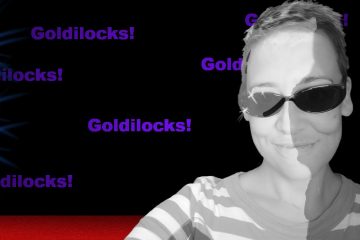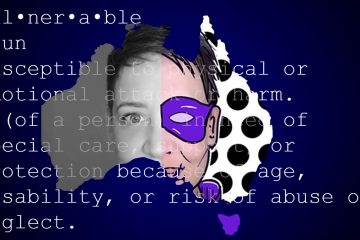Like breakfast and brushing my teeth, epilepsy is something I just ‘do’. Some people paint, some people knit, I ‘epilepsy’. This is not to imply this condition defines me, nothing could be further from the truth. This is to state that every now and again I’m taken over by this whole other person and yet I am still (just a little bit) in charge.
I’ve done this by naming she who hijacks my brain; I’ve named her Epilepsy Goldilocks.
Epilepsy Goldilocks and I have been through a lot; we’ve had the condition for nearly 30 years and my seizures have never been fully controlled. To add to this exasperation, they’re constantly changing. I’ve had absences; gelastic (giggling); generalised; nocturnal; and (the current flavour of the month) focal impaired awareness seizures.
The seizure tasting menu I’ve been working my way through has made it outrageously problematic to find the correct combination of anti-epileptic meds. And it’s an issue that seems to be continuing, I’m currently on 4 different medications: each one at a pretty high dose. So, in February ’18 when I was offered vagus nerve stimulator (VNS) surgery, I jumped at it; talk about a no-brainer.
The VNS was implanted on 1 September ’18. With my bionic birthday creeping up, I look back over these last 2-years and it hasn’t all been plain sailing, easy peasy or hunky dory. (Although, when the subject is epilepsy-related, is it ever plain sailing, easy peasy or hunky dory?) It became apparent quite early on that my poor-little-brain is incredibly sensitive to the electrical pulses emitted by the VNS.
This is both a good and a not-so-good thing.
It’s not-so-good in that the top bods recommend the ‘dosage’ of the stimulator is as high as possible, for as much of the day as possible, to maintain therapeutic efficacy. However, it’s great in that even though my brain is receiving relatively low electrical pulses, for just 10% of each day, I’ve seen some incredible changes.
My VNS uber-sensitivity came to light within the first 3-months of having the surgery, is not uncommon and is easily rectified. By December ’18, with .25mA increases every 2-weeks, I’d reached a setting of 1.5mA and had horrendous jaw pain with unbearable nausea. Dmitrij, my VNS nurse had adjusted several settings and to maintain therapeutic efficacy (important for treatment), alongside tolerability (important for Goldilocks) we agreed it would be dropped.
Slightly.
It was emitting 1.5mA, every 5 minutes for 30 seconds. It was reduced to 1.375mA, every 1.8 minutes for 7 seconds. This meant I still had stimulation for 10% of 24 hours just at a different ratio. A ‘shorter-burst’ setting can be preferable for us VNS robots with more electro-delicate-brains.
February ‘19, I had a follow-up and for the first time ever, I was looking forward to a hospital visit. It wasn’t a chore seeing the nurse, despite the trek to London, despite the organisation, the hotel rooms or how weary it makes me. It wasn’t a chore because my VNS nurse (for the space of our appointment at least) prioritised my condition with the same level of importance I do. I enjoyed it because he not only listened to me but he answered my questions. Dmitrij gets I’m the expert when it comes to my condition; I’m the one with the VNS, I’m the one with epilepsy.
Well, and Epilepsy Goldilocks, but we know how helpful she is!?
In this appointment we agreed that bringing the output levels up might be a good idea. The levels were increased from 1.375mA to 1.625mA every 1.8 minutes for 7 seconds, and I tolerated it. It just turns out my stoopid-brain needed a little more than 2-weeks to adjust.
It’s now July ‘20, 21-months(ish) since the surgery. After several visits to London for tweaks and adjustments I found the setting that was (ahem) ‘just right’. VNS treatment is incredibly personalised (it’s inside the individual after all), what’s awesome for one robot may not benefit the next robot in the slightest. In this way the VNS is much like pharmaceutical therapies, each patient’s cocktail of medications is carefully tailored. Unusually in February ’20 (just before lockdown) I moved, what could be considered backwards to settings I’d had 8-months earlier in June ‘19.
Since a previous increase, in October ‘19, pain had started to build in my neck and jaw, so I visited the dentist (not the first time I’ve done this). It was my dentist who discovered the muscles on the left side of my neck were in spasm. The VNS at this point was stimulating every 1.1 minute, which meant my neck muscle was constantly triggered and never given any time to just chill. This was resolved by a shorter burst of stimulation and increasing the amount of time between stimulations. The relief I felt was instant.
In that I’ve found my settings sweet spot I can now say unequivocally (perhaps even with some authority), my VNS is decreasing the number of seizures I have. It’s reducing the amount of time it takes for Epilepsy Goldilocks to disappear and Goldilocks to return; I feel stronger, calmer and better-able-to-deal-with-stuff.
In February 2018 I had 16 witnessed seizures, including 1 nocturnal seizure. More than that, I felt awful, regularly fatigued and I was battling anxiety. In February 2020 I had 11 witnessed seizures and 1 nocturnal event. And I feel a whole lot better within myself.
In both 2018 and 2020 there were (probably) events happening of which I wasn’t aware. In 2018 this would leave a constant weight of exhaustion over me, now because of the VNS and lifestyle changes this is not the case (to the same extent). I’d be fibbing if I said I never needed a PJ-wearing-drinking-tea-in-bed day but these are way fewer and further between.
I’d be remiss to say this was solely due to the VNS implant surgery 21-ish months ago. I’ve made a lot of other changes during this time: lifestyle adjustments; attitude modifications; I’ve relocated to an awesome seaside community where I’m supported. All these things in combination with the VNS have led to the positive outcomes I’m experiencing.
My seizures have declined in number over the last 2-years and as a knock-on effect so have injuries. In summer 2018 (prior to becoming an android) I was falling and getting a black eye every three weeks, always the left side. Yup, the half-panda was seen quite a lot on the island that year. I do as much as I possibly can to mitigate the chance of a seizure occurring and to minimise the fallout when it does.
And it will, it’s unpredictable.
When I fall and injure myself, I become incredibly emotional, especially if my wounds (be they bruises, cuts or scrapes) are visible. It’s because falling and the subsequent injury is a big-in-your-face-take-that type reminder that I’m constantly in jeopardy. Having a black eye or even the lesser-spotted-double-panda is like walking around with a big neon sign above my head flashing ‘Vulnerable Goldilocks’.
Interestingly (and unexpectedly) I’ve found having fewer seizures has bought with it a sense of disorder. It’s stirring up some strange emotions, a few odd thoughts. I feel bad that I feel good about having fewer seizures. I’m unnerved because my fingertips are scraping the thing which has always felt just out of reach. I’m not sure how to process this change I’ve been working towards my entire adult life.
I was diagnosed at 13. I’ve probably been having seizures since I was 4; I don’t know how life’s gonna go without epilepsy. It’s a great thing, truly awesome but I’m not instantly, automatically, immediately okay with it. And that’s what’s curious. These weird feelings of ‘what do I do now?’, ‘who am I now?’ or ‘what if my seizures come back with a vengeance, what happens then?’, aren’t questions I ever thought I’d have, never mind have to answer.
It’s not lost on me that the VNS is an expensive treatment and I’m fortunate to live in the UK where it (along with 4 different medications each month) has been provided by the (magnificent) NHS. I’m starting to see (though not yet consistently) fewer seizures but some don’t see any changes at all; I’m one of the lucky ones. Please don’t think I’m not grateful, I am. I’m excited to be in the position I’m in, yet I’m struggling to understand what happens now.
I’ve learned not to define myself by my epilepsy or through my seizures, but they remain a huge part of who I am. I’ve never even thought about having fewer seizures; it’s never been on the cards for me.
Until now.
Because having epilepsy is like being Goldilocks: you can’t have too much, you can’t have too little; everything has to be just right.
Copyright © Jo Mackenzie 2020



2 Comments
S-dawg · November 28, 2020 at 1:43 PM
Thanks for sharing your experience with VNS. I have seizures because I have an inoperable brain tumor. I’ve tried all of the seizure meds over the eight years. This is my last hope of having fewer seizures, and hopefully no more grand mals.
034: VNS (with Mike Knox) - The Brain Ablaze Epilepsy Podcast · October 15, 2020 at 9:20 AM
[…] Viva Las Vagus! […]